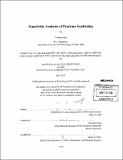| dc.contributor.advisor | Michael Fehler. | en_US |
| dc.contributor.author | Fang, Xinding, S.M. Massachusetts Institute of Technology | en_US |
| dc.contributor.other | Massachusetts Institute of Technology. Dept. of Earth, Atmospheric, and Planetary Sciences. | en_US |
| dc.date.accessioned | 2010-10-29T18:40:33Z | |
| dc.date.available | 2010-10-29T18:40:33Z | |
| dc.date.copyright | 2010 | en_US |
| dc.date.issued | 2010 | en_US |
| dc.identifier.uri | http://hdl.handle.net/1721.1/59789 | |
| dc.description | Thesis (S.M.)--Massachusetts Institute of Technology, Dept. of Earth, Atmospheric, and Planetary Sciences, 2010. | en_US |
| dc.description | Cataloged from PDF version of thesis. | en_US |
| dc.description | Includes bibliographical references (p. 40-42). | en_US |
| dc.description.abstract | We use a 2-D finite difference method to numerically calculate the seismic response of a single finite fracture in a homogeneous media. In our experiments, we use a point explosive source and ignore the free surface effect, so the fracture scattering wave field contains two parts: P-to-P scattering and P-to-S scattering. We vary the fracture compliance within a range considered appropriate for field observations, 10-12 m/Pa to 10-9 m/Pa, and investigate the variation of the scattering pattern of a single fracture as a function of normal and tangential fracture compliance. We show that P-to-P and P-to-S fracture scattering patterns are sensitive to the ratio of normal to tangential fracture compliance and different incident angle, while radiation pattern amplitudes scale as the square of the compliance. We find that, for a vertical fracture system, if the source is located at the surface, most of the energy scattered by a fracture propagates downwards, specifically, the P-to-P scattering energy propagates down and forward while the P-to-S scattering energy propagates down and backward. Therefore, most of the fracture scattered waves observed on the surface are, first scattered by fractures, and then reflected back to the surface by reflectors below the fracture zone, so the fracture scattered waves have complex ray paths and are contaminated by the reflectivity of matrix reflectors. | en_US |
| dc.description.statementofresponsibility | by Xinding Fang. | en_US |
| dc.format.extent | 42 p. | en_US |
| dc.language.iso | eng | en_US |
| dc.publisher | Massachusetts Institute of Technology | en_US |
| dc.rights | M.I.T. theses are protected by
copyright. They may be viewed from this source for any purpose, but
reproduction or distribution in any format is prohibited without written
permission. See provided URL for inquiries about permission. | en_US |
| dc.rights.uri | http://dspace.mit.edu/handle/1721.1/7582 | en_US |
| dc.subject | Earth, Atmospheric, and Planetary Sciences. | en_US |
| dc.title | Sensitivity analysis of fracture scattering | en_US |
| dc.type | Thesis | en_US |
| dc.description.degree | S.M. | en_US |
| dc.contributor.department | Massachusetts Institute of Technology. Department of Earth, Atmospheric, and Planetary Sciences | |
| dc.identifier.oclc | 671400332 | en_US |
